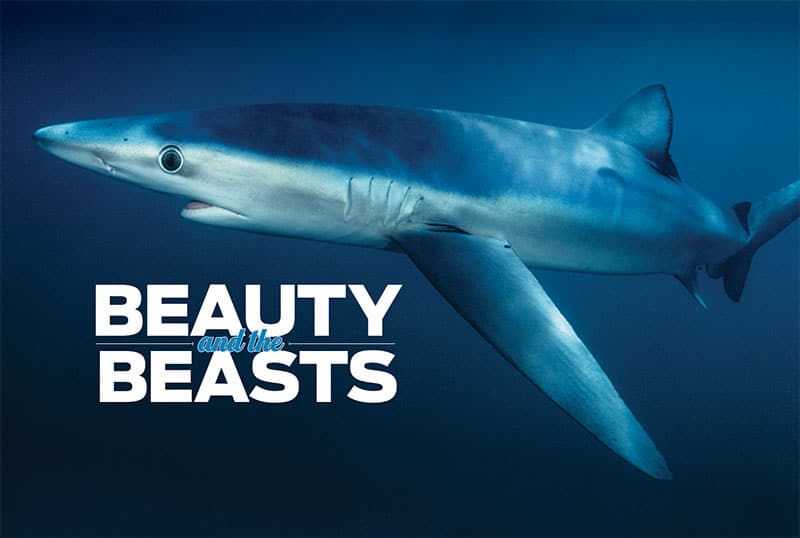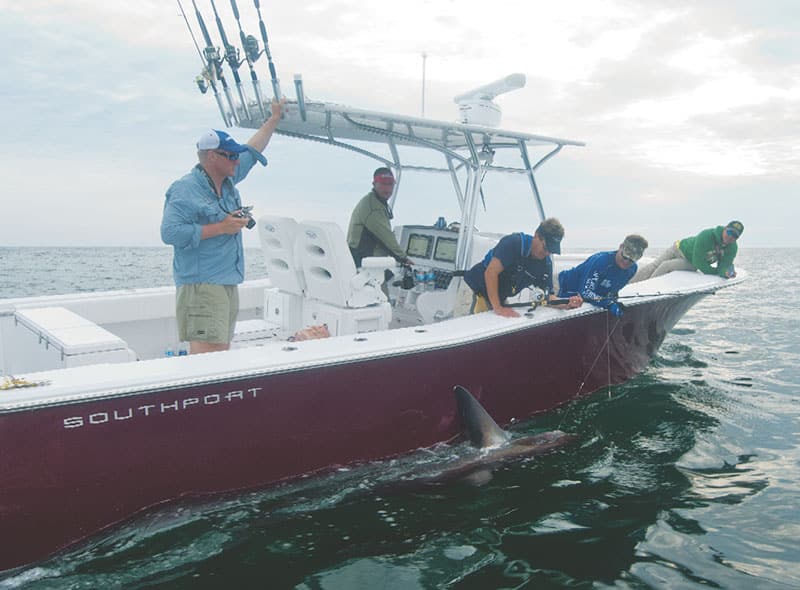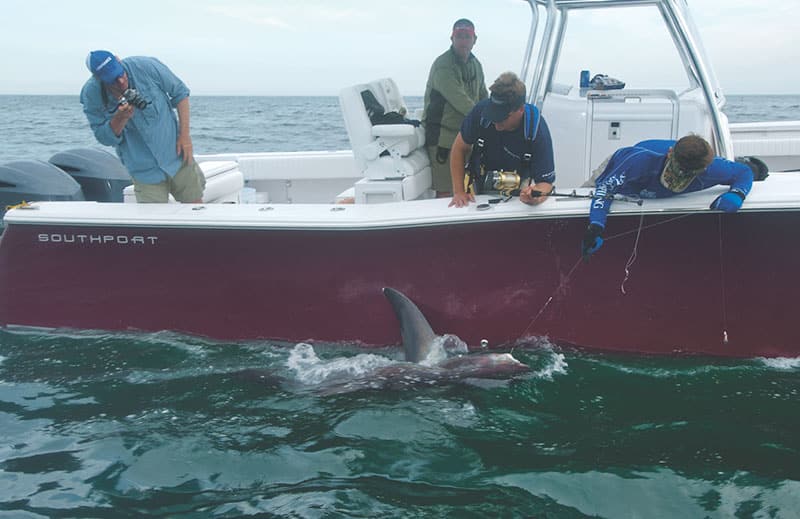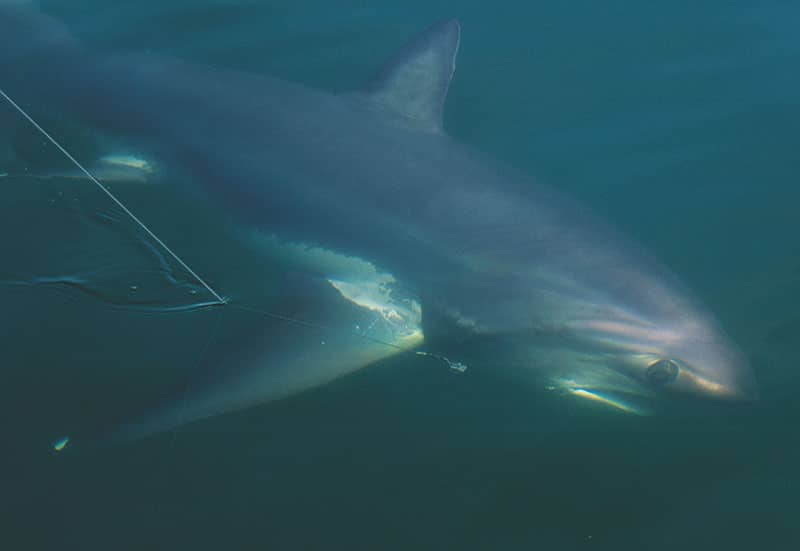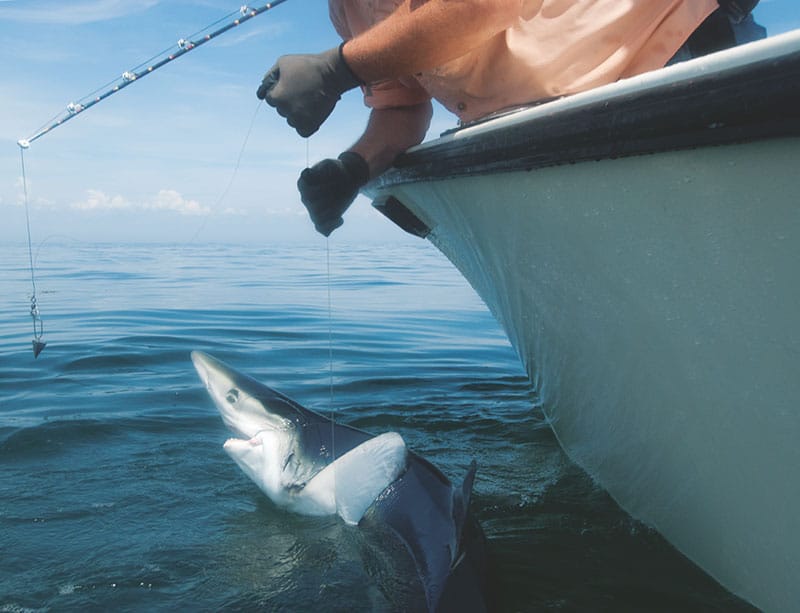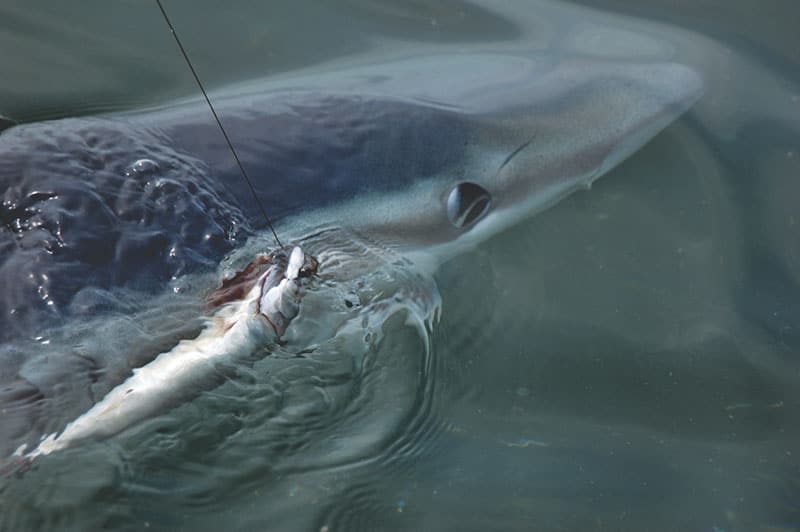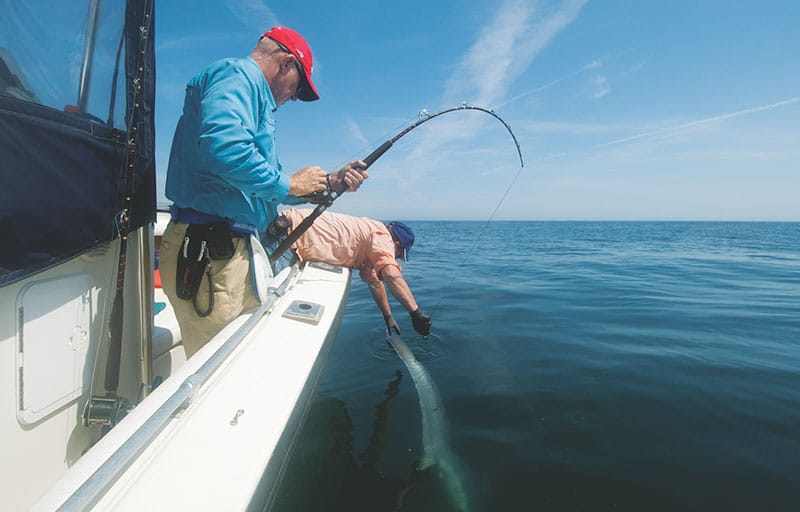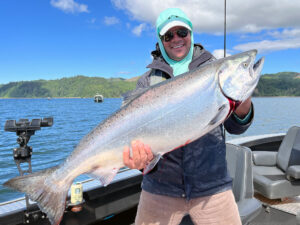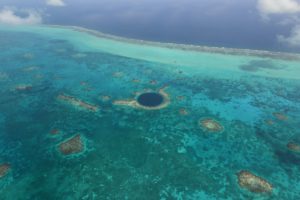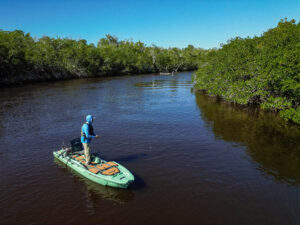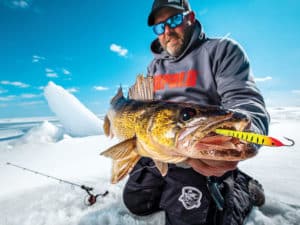[Be sure to click through all the images in the gallery above.]
The folks at Maine tourism could not have written a better script: Spotless sky over a still, serene sea; finback and minke whales surfacing, blowing, gliding; sharks darting through the chum; potential state-record blue shark on fly; not one but two thresher sharks — estimated at 165 and 360 pounds.
About the only thing missing that August day was a mako. But let’s not get greedy. To top it all off, for the first hour or so, all the fish came to my boat. As the saying goes: I’d rather be lucky than good.
However, last summer, I had both fortune and skill working for me. I had come to Bath, Maine, to target sharks and striped bass with Capt. Dave Pecci of Obsession Sportfishing Charters (207-841-1444; obsessioncharters.com), and an assortment of industry friends from Southport Boats, Seaguar, Navico, and** L.L. Bean**. This outdoor playground at the country’s northeastern tip combines visual majesty, seafaring history, and a healthy dose of offshore and inshore action.
**Second Wind
**But the trip didn’t start out all textbook and perfect. The outboard on Pecci’s boat died, so he borrowed his friend John Fitzpatrick’s 23 Seacraft. Then the crew on our second boat, a Southport 29 CC, found thick fog on their trip to our berth at the Kennebec Tavern & Marina.
That goes to show you that even seemingly dark clouds eventually part. Our second day dawned with sudden gusto.
After shooting some photos of the new Southport, our group of nine anglers in the two boats settled down for the offshore trip. Our captains hammered the throttles — though as you might expect, the single-outboard 23 quickly fell behind. Still, the 18-mile run from the mouth of the Kennebec River took minimal time, and soon Pecci had set up a drift offshore from a commercial bluefin tuna fleet in 450 feet of water.
Although we were over a spot Pecci called the Elbow off Murray Hole — where the bottom rises from 450 to 360 feet — he added that the sharks react more to tide lines and current rips than structure. “I’d also like the temperature to increase a couple of degrees,” he said, reporting that the gauge read 65.5. “That would concentrate the sharks more.”
Thankfully we needed no warming trend. Pecci put a block of chum into a lidded milk-crate container and tied it off the transom. He cut slits into a jug of fish oil and hung that off another cleat. He also cut some mackerel chunks to periodically toss into the scent trail.
“Usually it takes about an hour or 90 minutes for these sharks to come in,” he said confidently. Sixty minutes later, we spotted the first flyby — a blue shark that nosed around the chum block.
**Program Prep
**Pecci had armed us with a pair of 30-pound-class, conventional stand-up outfits spooled with 100-pound PowerPro braid. He doubled about 10 feet of line with a Bimini twist tied to a snap swivel. To that, he attached six feet of 200-pound mono, “something I can get a grip on,” he says.
To the mono, he tied a snap swivel that clasped a 10-inch section of 100-pound stainless leader haywired to a 7/0 J-hook. Pecci deliberately makes somewhat loose haywire connections so that their breaking strength averages about 70 pounds. “When I’m handling the shark up close to the boat, I want them to fail,” he says.
Pecci pinned a whole, dead Atlantic (Boston) mackerel to the hook, threading it up through the bottom jaw and out the top of the head. He tied a balloon onto one rig about 30 feet above the bait. He suspended the second mackerel just a few feet below the second balloon, just deep enough to deter the shearwaters, and then drifted the baits 20 to 30 yards behind the boat.
Pecci also rigged a pitch bait on a spinning rod, spooled with 50-pound braid. Mac McKeever, an avid fly fisherman and public-relations rep with nearby L.L. Bean in Freeport, Maine, hauled out a 6-foot-9-inch, 14-weight fly rod and a chum fly.
**On Fire
**Our first flyby blue shark pestered the chum crate like a hungry pup but left without bothering the mackerel. A few minutes later, the balloon holding the shallower bait began to move. As the shark began swimming strongly, Spud Woodward, my better half and a coastal-resources manager from Georgia, reeled like a madman and struck the fish.
It sounded to 150 feet and hung at that depth, an immovable beast. “I wonder if he’s pec-wrapped,” Pecci mused, peering over the side of the boat into the green water. With the sea as calm as a just-drawn bath, we actually could see the fish on the Seacraft’s fish finder, marking a large red streak.
This was no frenzied blue shark. Betting on a thresher, Pecci watched expectantly as Spud kept the pressure on the fish, and it finally started rising. After 30 minutes, we saw the distinct, elongated upper-caudal fin.
Water definitely magnifies objects, so this shark looked huge. Of course, its tail doubled its body length to about 11 feet. As Pecci attempted to subdue the fish boat-side for photos, that tail smacked him in the head, knocking off his hat. On his second try, the fish swatted Spud in the shoulder and caught me on the thighs. We cut the wire close and backed away as the shark swam off slowly.
In short order, the blue sharks found us. But these fish weren’t the same lean, scrappy animals I’ve caught off the Pacific Coast. We had near-constant action on very respectable blues, measuring up to nine feet in length. Our fourth fish became so enamored with the boat that it stayed close even after hookup. Finally, it spooked and ran off 250 yards of line in an instant. The 8-footer probably weighed more than 130 pounds.
Blue shark No. 7 circled the chum bucket and the outboard as McKeever tried presenting a fly. After a couple of hopeful passes, it sucked in the feathers and hackle, and McKeever was tied into a potential state-record fish.
Rather than boat the shark and apply for the record, McKeever released the fish. At the same time, anglers on the Southport boat, drifting nearby, scored repeated back‑to‑back double hookups, including one blue shark on a Shimano Orca topwater plug.
Final Act
And then they hooked Goliath — or as close to that Biblical giant as anything we had recently seen: a 360-pound thresher shark. Sport Fishing‘s Northeast sales manager Matt White said he saw the shark jump.
Ian Kopp, Southport’s president, watched as his line steadily peeled off the Shimano Tiagra, and then didn’t return. He battled the fish initially with only a rod belt for assistance, cranking back inches of line at a time, as White, at the helm, tried to help him gain an angle on the fish.
The hookup came late in the day, so as more than an hour ticked off the clock, the sun’s glare began to soften. Finally the fish wearied, and SF publisher Dave Morel reached for the leader. Morel held the fish’s head near the boat forward of the amidships line; the tip of its tail fluttered near the props. At full length, it topped 15 feet.
I wondered if Kopp could still bend his back. But it didn’t much matter: Judging by the smile on his face, I’m sure he didn’t feel it.
Don’t miss: Additional photos and a video shot while fishing on location in Bath, Maine, and a profile of the Southport 29 CC.
**Bath Bass
**
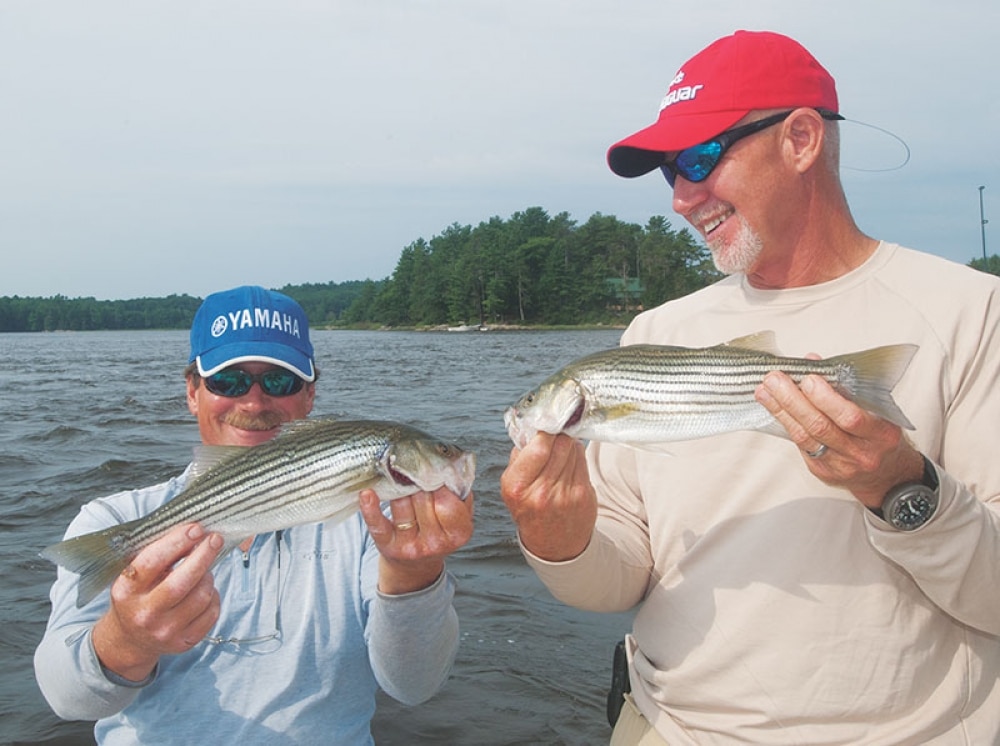
I started this article writing about shark and striper fishing. But the striper fishing on this particular trip last August paled in comparison to the sharking.
We made two trips to usually productive bass grounds, drifting deep holes and ledges, baiting bigger fish with eels and smaller fish with sandworms. The baby bass proved plentiful, but legal-size fish avoided us.
The deep Kennebec River (certain spots exceed 100 feet), which hosts Bath Iron Works and its historic shipbuilding reputation, actually harbors a small, native population of striped bass. It also holds migrant bass from the Chesapeake Bay and Hudson River — when the fish make it this far north.
“You never know where they’ll settle out on the coast. If they get the right food and temperature, they might stay there,” says Capt. Dave Pecci of Obsession Sportfishing Charters. Also, during midsummer, the bass eat less often because of the warmer water temperatures, he says. Often, the best time to catch them can even be September, when the fish mass to migrate south.
Pecci’s best striped bass ever from the Kennebec: a 52-pounder.
**Maine Attraction
**
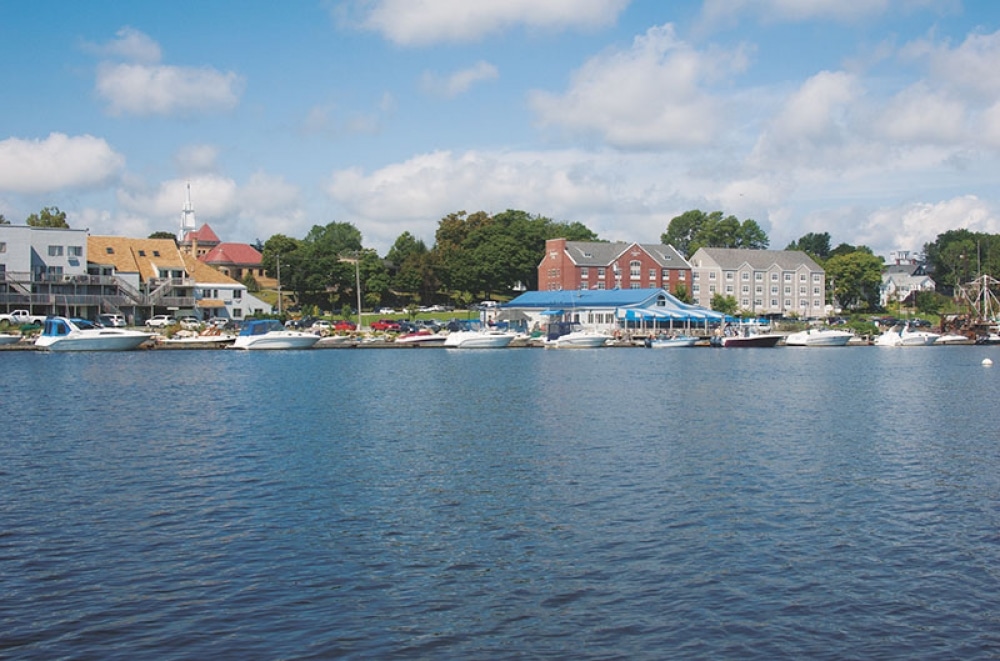
Maine carries an allure for many Americans similar to that of Alaska: It’s remote, wild and achingly beautiful. And similar to its Northwest counterpart, Maine offers a short window of fishing opportunity that spans late spring through summer.
True, when comparing species and sheer abundance, the two locations differ. In the Northeast, robust commercial fishing in these more-accessible waters predated most regulations. But Maine offers tremendous opportunities for bluefish and striped bass, including sight-casting, plus offshore bluefin tuna and shark fishing.
Bath, about 40 minutes north of Portland’s easily accessible airport along the midcoast of Maine, calls itself “Maine’s Cool Little City” and the “City of Ships.” Both fit this incredibly charming location — home to 9,000 residents — which features a historic downtown, fronting the Kennebec River. “It’s more of a real community than ultra touristy,” says Capt. Dave Pecci, our fishing host.
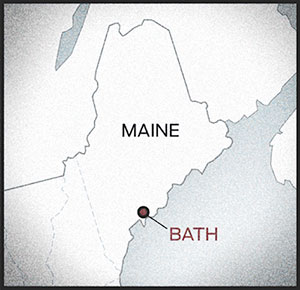
We stayed at the new Hampton Inn at the north end of the waterfront, directly across the street from the Kennebec Tavern & Marina. Pecci docks his boat at the marina’s floating docks; we also berthed the Southport 29 there during our trip. The tavern features excellent local lobster and fish dishes — a must-have for any Maine visit.
Transiting the river offers anglers an optimal look at the region’s offerings. The river near Bath features a swift tidal current; it’s lined with a variety of lighthouses, and terminates at a rocky coastline with nearby beaches and a Civil War-era fort (Popham).
Two of Bath’s other main attractions include the Bath Iron Works, which was opened in 1884, and postdates the area’s vibrant wooden-shipbuilding era of the 1840s and ’50s. The active site, now owned by General Dynamics, offers trolley tours. Just downriver, the Maine Maritime Museum honors the sea’s dominance of the region’s economy.
| For more information about fishing the Bath region, contact:Capt. Dave Pecci Obsession Sportfishing Charters 207-841-1444 obsessioncharters.comMaine Charter Captains Association mainechartercaptains.orgMaine Department of Marine Resources maine.gov/dmr/recreational | For more information on visiting Bath, contact:Hampton Inn, Bath 207-386-1310 hamptoninn3.hilton.comKennebec Tavern & Marina 207-442-9636 kennebectavern.comMain Street Bath visitbath.comMaine Office of Tourism 888-624-6345 visitmaine.com |
